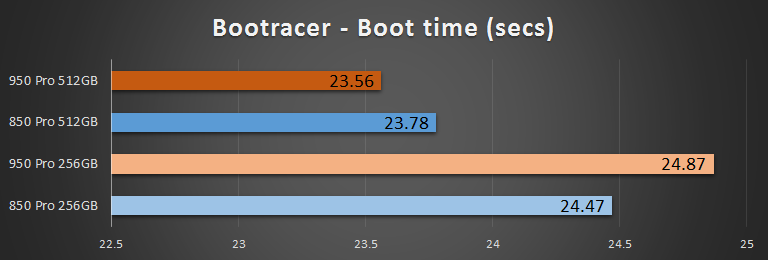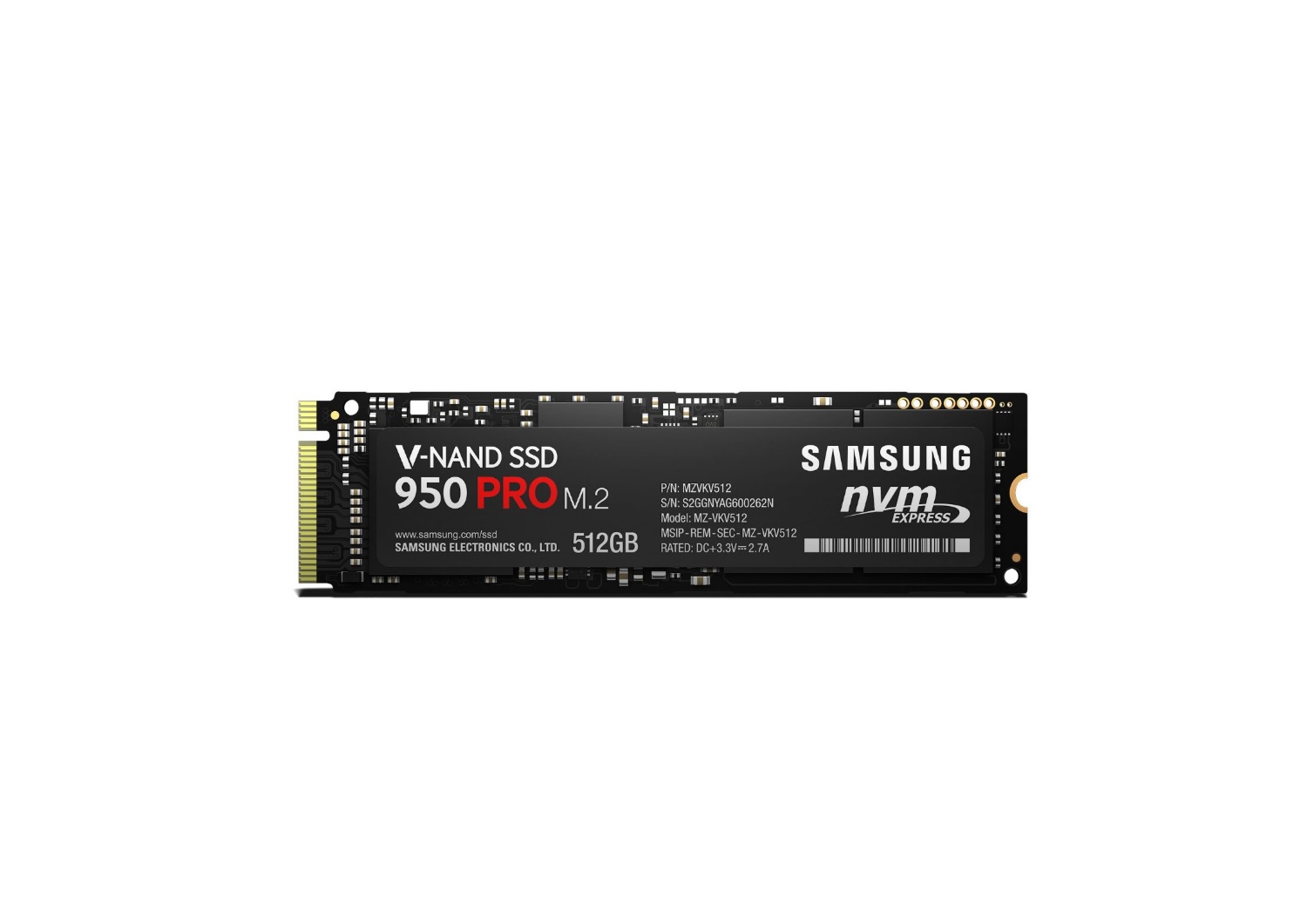Our Verdict
A very, very fast SSD that shows a strong future for M.2, but its speed advantage over SATA doesn't mean too much for gaming.
PC Gamer's got your back

For more on SSDs, check out our guide to the best SSDs for gaming.
More often than not, the latest piece of PC hardware is only a minor upgrade over its predecessor, offering slightly better performance and small improvements, but nothing that dramatically changes the game. It’s rare for new technology to outperform its predecessors so significantly it instantly makes them look dated.
The Samsung SSD 950 Pro is one such product. It features a whole new set of storage technologies that overcome the bottlenecks caused by older standards, which date back to a different era of PC tech. And with them, it improves performance enormously—at least some aspects of performance.
Like traditional 2.5-inch SSDs, the 950 Pro is based off NAND flash memory. But there are some big differences between the 950 Pro and traditional SSDs. Instead of SATA, the 950 Pro uses a different connector called M.2, which is built directly onto a PC’s motherboard. M.2 uses the PCI-Express bus for a much faster connection to the CPU than SATA, overcoming a major bottleneck in storage performance. SATA is limited to a theoretical maximum of 600MB/sec, a ceiling that many 2.5-inch SSDs have now reached, and cannot be overcome without a big change in the underlying technology.

The first generation of consumer motherboards to feature an M.2 slot was Z97, which arrived in early 2014 in conjunction with the second-generation ‘Devil’s Canyon’ consumer Intel processors like the Core i7-4790K. Since then, two more chipsets have arrived with M.2 support: X99, a high-end workstation / server chipset which is compatible with six-core and eight-core LGA2011 v3 processors, and Z170, which is the chipset that arrived this year with Intel’s new generation of consumer processors such as the Core i7-6700k, codenamed Skylake.
So to use the 950 Pro, you’ll need a motherboard in your PC that’s based on one of those chipsets. It’s a bit more complex than that, however, because there are some performance differences between them. M.2 in Z97 uses four PCI-Express 2.0 lanes which run at 500MB/sec each. X99 and Z170 use PCIe 3.0 lanes, which run at 1GB/sec each. This will obviously affect the speeds you get from the drive.
The 950 Pro has a few more tricks up its sleeve. In the same way the old SATA standard badly needed replacing, the old AHCI protocol, which governs the commands a PC can issue to storage devices, was designed in 2004, long before SSDs were really a consideration. It similarly needs an update. AHCI’s replacement is called NVMe. NVMe not only increases the number of commands that can be placed in a queue from 32 to 65536, it now allows for multiple queues, again up to 66536. Quite a leap. It also reduces latency, due to fewer register calls per IO command.
M.2 uses the PCIe bus for a much faster connection than SATA, overcoming a major bottleneck in performance.
The final aspect of the 950 Pro that’s worth mentioning is its use of Samsung’s 32-layer 3D flash memory technology, called V-NAND, as in the 850 Pro. V-NAND is quite different to typical planar NAND, as it stacks flash cells vertically and horizontally, rather than just horizontally, allowing for a much greater number of connections between them, better longevity and greater density.
The drive itself is a single-sided 80mm (also known as 2280) M.2 device, ensuring compatibility with as many motherboards as possible. There are just two capacities available: 256GB and 512GB, with a 1TB drive promised next year that will make use of 48-layer, higher density V-NAND. It’s quite possible to build double-sided M.2 devices but for now, Samsung is sticking with a single-sided format to make the drive as small as possible to fit into slim laptops.
All this technology schooling is to prepare you to understand how and why the 950 Pro’s performance differs from typical SATA SSDs, so let’s jump into some numbers.
950 Pro performance
Samsung quotes some really impressive performance figures for the 950 Pro. In their review guide, they say the 256GB model can manage 2,200MB/sec read and 900MB/sec write, while the 512GB model is capable of a monstrous 2,500MB/sec read and 1,400 MB/sec write. That’s between four and five times faster than a standard SATA SSD, and faster than other consumer PCI-Express SSDs.
An amazing leap forward, as are the quoted read IOPS (input/output operations per second). Samsung quotes up to 270,000 read IOPS and 85,000 write IOPS for the 256GB model and up to 300,000 read IOPS and 110,000 write IOPS for the 512GB model.
And we found that these quoted performance results matched what we saw in synthetic benchmark tests.
Crystal Disk Mark even showed slightly better figures, with read results of 2,278MB/sec and 2,537 MB/sec for the 256GB and 512GB 950 Pro models, respectively, while a 4K QD32 test in IOMeter showed read IOPS of 272,345 for the 256GB model and 351,253 for the 512GB model.
These figures are much higher than the 850 Pro, but the 256GB write IOPS notably aren’t much faster, as the 850 Pro result was 82,000, just 3000 IOPS less than the 256GB 950 Pro.
But for a closer look at the 950 Pro and gaming performance, we tested both drives to see their loading times with a PC game that gobbles up a large amount of storage: GTA V, which has a huge 60GB install.
We used a stopwatch to measure the time it took from clicking the icon on the desktop to the main menu appearing, and again timed how long it took from selecting the ‘Start Game’ option in the menu until the ‘Go to the guard’ message appears on the screen during the first scene of the game.
It’s not a completely scientific test, and these sequences have loading screens and fixed-speed animation, so the overall time depends on more than just the SSD’s performance.
But it seems these loading times were just about the same on the 950 Pro as they were on the 850 Pro. In two of the tests, there’s no real difference between the drives at all, and in the other two, when loading the main game itself, there’s a difference of around a second. Although with the 512GB models, it’s the 850 Pro, not the 950 Pro, that works out to be faster. But with less than 2 seconds difference, it’s still within the margin of error, and the real conclusion to be had is that the massive difference in sequential read and write speeds between SATA and PCI-Express SSDs does not mean a massive difference in real-world performance.
This slightly changes how we feel about the 950 Pro. Having those raw performance figures from a storage device that’s smaller than the average human finger is technically astounding, but it won’t really change much about how you use your computer or play games. Windows doesn’t boot particularly faster, and games don’t load much quicker. From what we’ve seen, frame rates are unaffected.

But we’re still blown away by the raw benchmark results. M.2 offers great sequential performance, the speeds are brilliant and a 950 Pro will make a nice additional purchase when building a Skylake-based gaming PC. But it doesn’t offer significant improvements to real-world performance, especially when gaming, and therefore this performance is a luxury, rather than essential.
Samsung’s SSD 850 Pro came with a massive 10-year warranty. The 950 Pro’s has been dropped to five years, although it offers greater overall longevity than the 850 Pro. The 256GB 950 Pro has quoted endurance levels of 200TBW, while the 512GB model goes up to 400TBW. This is an improvement over the 850 Pro, which already offered some of the most impressive endurance of any consumer SSD.
Pricing is $200 (£150) and $350 (£270) for the two capacities, although you’ll see different prices online as stock stabilizes. The pricing is reasonable, given that the 850 Pro is already one of the more expensive SATA SSDs you can buy. Older PCI-Express SSDs launched at much higher pricing than their SATA counterparts, particularly those that come in the traditional PCI card format.
You could save a few cents by opting for a cheaper SSD and ploughing those savings into a better graphics card, which will have a much bigger effect on gaming, advice that we think is absolutely worth following for anyone building a PC within a modest budget.
A very, very fast SSD that shows a strong future for M.2, but its speed advantage over SATA doesn't mean too much for gaming.


